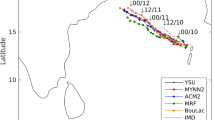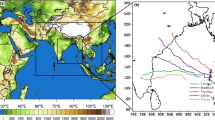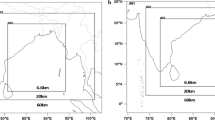Abstract
In this work the very severe cyclonic storm Thane which formed over the Bay of Bengal during 25–31 December 2011 and struck the East coast of India was simulated using the Weather Research and Forecasting (WRF)-Advanced Research WRF (WRF-ARW) mesoscale model. Normally, very severe cyclones rarely form in this late season. The moisture transport, intensity, track and structure of the cyclone is analyzed through vertically integrated moisture flux convergence and planetary boundary layer physics of the Yonsei University (YSU), Mellor–Yamada–Janjic (MYJ) and Asymmetrical Convective Model version 2 (ACM2) schemes. Cyclonic circulation and moisture convergence are seen 6 days ahead of the development of the cyclone and strengthened by the transport of moisture advected from the South China Sea. From the three planetary boundary layer (PBL) schemes, the YSU scheme gives better results both qualitatively and quantitatively for the moisture flux convergence. The MYJ scheme produced the least errors for cyclone intensity from genesis to the landfall stage, while the ACM2 scheme gave better results after landfall. The track of the cyclone with the YSU scheme produced the least errors throughout the life cycle which gives the least landfall error. The structure of the cyclone in terms of tangential winds, the spatial distribution of cloud bands, vertical cross section of temperature anomaly, relative humidity and vertical winds was well simulated by the ACM2 scheme.












Similar content being viewed by others

References
Anthes, R.A., Chang, S.W. (1982). Tropical cyclones: their evolution, structure and effects. Meteorol. Monogr. Ser., American Meteorological Society, Boston, MA, 19, 41, 208.
Byers, H. R. (1944). General meteorology (pp. 1–670). New York: McGraw-Hill.
Bhaskara Rao, D. V., & Hari Prasad, D. (2006). Numerical prediction of the Orissa super cyclone (1999): sensitivity to the parameterisation of convection, boundary layer and explicit moisture processes. Mausam.,57(1), 61–78.
Bhaskra Rao, D. V., & Hari Prasad, D. (2007). Sensitivity of tropical cyclone intensification to boundary layer and convective process. Natural Hazards,41, 429–445.
Boutle, I. A., Belcher, S. E., & Plant, R. S. (2011). Moisture transport in midlatitude cyclones. Quarterly Journal Royal Meteorological Society,137, 360–373.
Braun, S. A. (2006). High-resolution simulation of Hurricane Bonnie (1998). Part II: water budget. Journal of Atmospheric Science,63, 43–64. https://doi.org/10.1175/JAS3609.1.
Cody, F., & Wang, Z. (2014). Water vapor budget in a developing tropical cyclone and its implication for tropical cyclone formation. Journal of Atmospheric Science,71, 4321–4332. https://doi.org/10.1175/JAS-D-13-0378.1.
Davis, C. A., & Bosart, L. F. (2001). Numerical simulations of the genesis of hurricane Diana (1984). Part I: control simulation. Monthly Weather Review,129(1859–1881), 2001.
DiMego, G. J., & Bosart, L. F. (1982). The transformation of tropical an extratropical cyclone. Part II: moisture, vorticity and kinetic energy budgets. Monthly Weather Review,110, 412–433.
Environmental Modeling Center. (2003). The GFS atmospheric model, NCEP Office Note 442,14 pp. http://www.emc.ncep.noaa.gov/officenotes/newernotes/on442.pdf).
Gray, W. M. (1968). Global view of the origin of tropical disturbances and storms. Monthly Weather Review,96, 669–700.
Hong, S. Y., Dudhia, J., & Chen, S. H. (2004). A revised approach to ice microphysical processes for the bulk parameterization of clouds and precipitation. Monthly Weather Review,132, 103–120.
Hong, S. Y., Noh, Y., & Dudhia, J. (2006). A new vertical diffusion package with explicit treatment of entrainment processes. Monthly Weather Review,134, 2318–2341.
Huffman, G. J., Adler, R. F., Bolvin, D. T., Gu, G., Nelkin, E. J., Hong, Y., et al. (2007). The TRMM Multisatellite Precipitation Analysis (TMPA): quasi-global, multiyear, combined-sensor precipitation estimates at fine scales. Journal of Hydrometeorology,8(1), 38–55. https://doi.org/10.1175/JHM560.1.
Kain, J. S. (2004). The Kain–Fritsch convective parameterization: an update. Journal of Applied Meteorology,43, 170–181.
Kain, J. S., & Fritsch, J. M. (1993). Convective parameterization for mesoscale models: the Kain-Fritsch scheme. In K. A. Emanuel & D. J. Raymond (Eds.), The representation of cumulus convection in numerical models (p. 246). Boston: American Meteorological Society.
Kung, H., & Zhao, S. X. (2007). Diagnosis on energy budget and moisture supply of Matsa after landfall. Climatic and Environmental Research.,12, 437–452. (in Chinese).
Mellor, G. L., & Yamada, T. (1974). A hierarchy of turbulence closure models for planetary boundary layers. Journal of Atmospheric Science,31, 1791–1806.
Mellor, G. L., & Yamada, T. (1982). Development of a turbulence closure model for geophysical fluid problems. Reviews of Geophysics and Space Physics,20, 851–875.
Montgomery, M. T., & Farrell, B. F. (1993). Tropical cyclone formation. Journal of Atmospheric Science,50, 285–310. https://doi.org/10.1175/1520-0469.
Montgomery, M. T., Nicholls, M. E., Cram, T. A., & Saunders, A. B. (2006). A vortical hot tower route to tropical cyclogenesis. Journal of Atmospheric Science,63(1), 355–386.
NCEP FNL. (2000). National Centers for Environmental Prediction/National Weather Service/NOAA/U.S. Department of Commerce. 2000, updated daily. NCEP FNL Operational Model Global Tropospheric Analyses, continuing from July 1999. Research Data Archive at the National Center for Atmospheric Research, Computational and Information Systems Laboratory. https://doi.org/10.5065/d6m043c6.
Osuri, K. K., Mohanty, U. C., Routray, A., Kulkarni, A. A., & Mohapatra, M. (2012). Customization of WRF-ARW model with physical parameterization schemes for the simulation of tropical cyclones over North Indian Ocean. Natural Hazards,63, 1337–1359.
Palmen, E. (1948). On the formation and structure of tropical hurricanes. Geophysica.,3, 26–38.
Pleim, J. E. (2007). A combined local and nonlocal closure model for the atmospheric boundary layer. Part I: model description and testing. Journal of Applied Meteorology and Climatology,46, 1383–1395.
Pleim, J. E., & Xiu, A. (2003). Development of a land surface model. Part II: data assimilation. Journal of Applied Meteorology,42, 1811–1822.
Raju, P. V. S., Jayaraman, P., & Mohanty, U. C. (2011). Sensitivity of physical parameterizations on prediction of tropical cyclone Nargis over the Bay of Bengal using WRF model. Meteorology and Atmospheric Physics,113, 125–137.
Ramakrishna, S. S. V. S., Vijaya Saradhi, N., & Srinivas, C. V. (2012). On the role of the planetary boundary layer in the numerical simulation of a severe cyclonic storm Nargis using a Mesoscale model. Natural Hazards,63, 1471–1496.
Simpson, R. H., Frank, N., Shideler, D., & Johnson, H. M. (1968). Atlantic tropical disturbances, 1967. Monthly Weather Review,96(4), 251–259.
Srinivas, C. V., Bhaskar Rao, D. V., Yesubabu, V., Baskaran, R., & Venkatraman, B. (2013). Tropical cyclone predictions over the Bay of Bengal using the high-resolution advanced research weather research and forecasting model. Quarterly Journal Royal Meteorological Society,139, 1810–1825.
Srinivas, C. V., Venkatesan, R., Bhaskar Rao, D. V., & Hari Prasad, D. (2007). Numerical Simulation of Andhra Severe Cyclone (2003): model sensitivity to the boundary layer and convection parameterization. Pure and Applied Geophysics,164, 1465–1487.
Strong, G. S., Proctor, B., Wang, M., Soulis, E. D., Smith, C. D., Seglenieks, F., et al. (2002). Closing the Mackenzie Basin water budget, water years 1994/95 to 1996/97. Atmosphere-Ocean,40(2), 113–124.
Wang, Z. (2012). Thermodynamic aspects of tropical cyclone formation. Journal of Atmospheric Science,69, 2433–2451. https://doi.org/10.1175/JAS-D-11-0298.1.
Wang, Zhuo, & Isaac, Hankes. (2016). Moisture and precipitation evolution during tropical cyclone formation as revealed by the SSM/I–SSMIS Retrievals. Journal of the Atmospheric Sciences,73, 2773–2781. https://doi.org/10.1175/JAS-D-15-0306.1.
Wu, L., Su, H., Fovell, R. G., Dunkerton, T. J., Wang, Z., & Kahn, B. H. (2015). Impact of environmental moisture on tropical cyclone intensification. Atmospheric Chemistry and Physics,15, 14041–14053.
Xiu, A., & Pleim, J. E. (2001). Development of a land surface model. Part I: Application in a mesoscale meteorological model. Journal of Applied Meteorology,40, 192–209.
Zhou, T.-J., & Yu, R.-C. (2005). Atmospheric water vapor transport associated with typical anomalous summer rainfall patterns in China. Journal of Geophysical Research,110, D08104. https://doi.org/10.1029/2004JD005431.
Acknowledgements
The work presented in this paper is carried out under a research grant from the Board of Research in Nuclear Sciences (BRNS), DAE, Mumbai, India, vide reference 2008/36/89-BRNS/4019 dated 23/03/2009, and the authors acknowledge the same. The authors are thankful to the TRMM, NCEP FNL and GFS data centers for keeping the data sets available in the public domain. The authors also acknowledge the India Meteorological Department for making available all the observations for validation.
Author information
Authors and Affiliations
Corresponding author
Additional information
Publisher's Note
Springer Nature remains neutral with regard to jurisdictional claims in published maps and institutional affiliations.
Electronic supplementary material
Below is the link to the electronic supplementary material.
Rights and permissions
About this article
Cite this article
Ramakrishna, S.S.V.S., Rao, N.N., Ravi Srinivasa Rao, B. et al. Impact of Moisture Transport and Boundary Layer Processes on a Very Severe Cyclonic Storm Using the WRF Model. Pure Appl. Geophys. 176, 5445–5461 (2019). https://doi.org/10.1007/s00024-019-02279-0
Received:
Revised:
Accepted:
Published:
Issue Date:
DOI: https://doi.org/10.1007/s00024-019-02279-0



